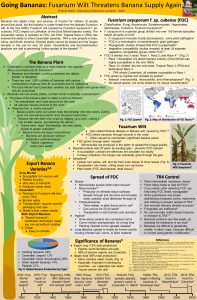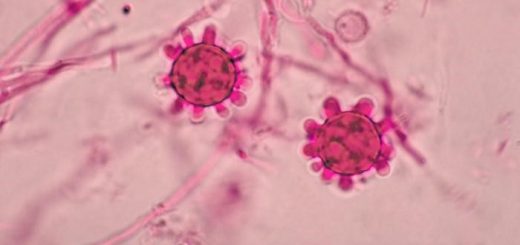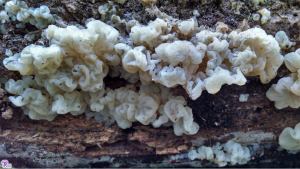#107: The Banana and Fusarium oxysporum f. sp. cubense

The banana that you know and love may soon be a thing of the past. I know, you probably think that I’m exaggerating the threat to this ubiquitous crop, but the possibility of bananas disappearing from grocery shelves forever is very real. In fact, it nearly happened once before. Here is a brief history of the modern banana: in the 1950’s, bananas were wiped out by a disease called Panama Disease. To save the crop, a resistant variety was discovered. Today, Panama Disease has evolved to attack the resistant variety, thus threatening to decimate banana production for a second time. This time, however, there is not a fallback option.
The most important theme when discussing agricultural diseases is monoculture. A monoculture is an agricultural system where an entire farm is planted with the same crop. Monoculture is ubiquitous in modern agriculture. It is easier to plant, tend, and harvest crops when all the crops in a field are the same. Nowadays, plants are also genetically identical. This ensures consistency in the food supply but also carries some big risks. Since all the plants are genetically identical, they are all susceptible to the exact same set of adverse conditions. If they are not drought-tolerant, a mild drought could kill every last one of them. Similarly, if one becomes infected with a disease, all of the plants will be infected with the same disease in a matter of days.
The best example of the dangers of monoculture is the Great Famine of Ireland (a.k.a. “The Irish Potato Famine”). At that time, the Irish population was completely dependent upon the potato for food, so the entire nation was plunged into famine when a disease killed off 100% of the potato crop. Agricultural history is littered with examples like this, and the banana is one of those.
Bananas have been cultivated for a very long time. The banana was first cultivated somewhere in Southeast Asia, where many banana relatives still grow wild. Samples of organic material found at archaeological sites suggest that banana cultivation began around 5,000 BCE. A Sanskrit text dating from around 500 BCE is believed to contain the first written reference to the banana. After spreading across Southeast Asia, Arabic peoples brought the banana to Africa. In fact, the word “banana” comes from the Arabic word for “fingers.”
With the advent of refrigeration, bananas could be transported across oceans. As a result, exporting bananas became a profitable enterprise during 1870’s. Large banana plantations were established in Central and South America, turning this tropical fruit from a delicacy to a food staple for millions of people in the United States and Europe by the early 20th century. The widespread cultivation of bananas in the tropical Americas had important political consequences in the 20th century, which, unfortunately, are somewhat beyond the scope of this post. If you don’t remember learning about United Fruit in school, please skim the New Yorker article, linked below, for an overview of banana politics.
To understand the problems plaguing bananas, it will help to learn a little bit about banana biology. Modern bananas (including plantains, which are only distinguished from bananas in certain parts of the world) descend from two ancient species: Musa acuminata and Musa balbisiana. Many modern banana varieties result from crosses between the two species, but the two most important varieties (Gros Michel and Cavendish) only contain genes from M. acuminata.
Bananas are great for eating because they have no seeds. There are two reasons for seedless bananas. First, most bananas are triploid, which means they have three sets of chromosomes. This makes it nearly impossible for seeds to receive one or two complete sets of chromosomes. It is far more likely that each gamete produced in meiosis will receive 1.5 sets of chromosomes. Plants do very well with multiple sets of chromosomes (polyploidy generally increases hardiness and disease resistance), but they must be complete sets. The chances that two gametes will meet with the correct chromosomes to form three complete sets are infinitesimally small. Second, bananas can form fruit without being fertilized (called parthenocarpy). Without pollination, seeds will not form regardless of how many chromosomes the plant has. Thanks to parthenocarpy, bananas form fruit even though they don’t produce any viable seeds.
Wild bananas do form black, pea-like seeds, which can be found distributed among the flesh in the middle of the banana (thus making the banana technically a berry). The brown specks at the center of seedless bananas are the remnants of unfertilized ovules, which would have produced seeds if it were possible. Please note that although it may somewhat resemble a bean, the banana is not related to the bean family.
Although it can reach heights of 15 meters, the banana is not a tree. Instead, it is the world’s largest flowering herb. The “trunk” or “stem” of a banana plant is actually a pseudostem, which is a tightly-packed spiral of leaves. The pseudostem connects to the roots through a structure called a “corm,” which is a tight, fleshy bundle of roots. The corm allows the banana to reproduce asexually by sending out suckers. Each sucker is connected to the corm via roots and can form a new corm, pseudostem, etc.
Reproducing asexually by suckers is a very useful ability. Since bananas cannot reproduce through seeds, farmers have to propagate their crops using corms. Corms can be dug up and brought to new areas, thus quickly expanding banana production. Once the banana produces fruit, the pseudostem dies. To make new pseudostems, all a farmer has to do is cut down the old stalk and all but one of the suckers. The sucker will then grow into a new plant, thus propagating the banana plant indefinitely. This makes it very easy to recover from natural disasters like hurricanes, but it also means that every plant on a plantation is genetically identical.
You now know enough about bananas to understand the problems facing the banana industry. However, there is a lot more you can learn about bananas. I encourage you to visit one of the websites listed under “See Further” (below) that is marked with an asterisk to learn about banana fruit growth, harvesting, artificial ripening, varieties, and the economics of banana cultivation.
The banana that dominated markets in the late 19th and early 20th centuries was known as the “Gros Michel” variety (in English-speaking areas, this variety is often called “Big Mike,” which is a literal translation of its French name). Compared to bananas found on supermarket shelves today, the Gros Michel tasted better, did not bruise as easily, lasted longer, could be transported more easily, and did not need to be artificially ripened. Unfortunately, this banana variety had absolutely no resistance to a disease called “Panama disease.”
Panama disease was first noticed in Australia in 1876. Here, Gros Michel bananas began dying inexplicably. The lower leaves would turn yellow from the outside in and then wilt and die. This spread up the plant until the entire plant died. On the inside, the pseudostem turned brown and began rotting, starting with the outer layers. Since most bananas grown for export were produced on plantations in the tropical Americas, the Australian problems were not very alarming.
From Australia, the disease spread to Indonesia and then to Central and South America, reaching Cuba by 1910. The disease slowly worked its way throughout the banana-growing regions of the Americas for the next 40 years. In the 1950’s, the disease reached epidemic proportions. Entire plantations were destroyed by Panama disease. In an attempt to get away from Panama disease, plantations were often abandoned and started up in new areas. Regrettably, the disease was not fully understood and these new plantations quickly went the way of their predecessors. In 1965, the Gros Michel banana was declared commercially extinct.
The banana industry was saved by a stroke of luck: growers found a commercially viable banana variety called the “Cavendish” that was resistant to Panama disease. The Cavendish had a relatively bland taste, was much more difficult to transport, and was susceptible to a greater number of other diseases, so its adoption was rather slow. Only in the 1950’s – when all other options had been exhausted – did banana companies begin widespread cultivation of the Cavendish banana.
Panama disease is caused by the fungus Fusarium oxysporum f. sp. cubense, commonly referred to simply as “Fusarium.” This fungus attacks the banana’s vascular system. In plants, the vascular tissue is responsible for transporting water, sugar, and other nutrients between the leaves, roots, and other parts of the plant. Fusarium gets into the banana through wounds in the roots or corm, commonly caused by nematodes (which can be a severe pest in their own right). From there, the fungus grows along the xylem and phloem channels that make up the plant’s vascular tissue. Thus, Fusarium spreads along roots and leaf stems, slowly making its way towards the center of the plant.
As it grows, the fungus kills the banana plant’s vascular cells (and any other nearby cells) and absorbs their nutrients. The end result is that the plant’s water and food supply gets choked off. Because of this, the initial symptoms of Panama disease resemble those of a plant without an adequate water supply: the leaves turn yellow and wilt. It is easy to see where the fungus has been at work when the pseudostem is cut open. Cells infected by the fungus turn reddish-brown and smell strongly of garbage. Additionally, uninfected roots become weak and die because they cannot get enough sugar from the leaves.
Fusarium is primarily a soil-borne pathogen. It produces resilient, asexual resting spores that can persist in the soil for decades. The spores germinate when new banana roots grow near them, thus infecting all banana plants in the area for years to come. Spores can be easily transported from one area to another with soil stuck to shoes, farm equipment, and even transplanted banana corms. This was not known in the 1950’s, so farmers who started new plantations inevitably brought the disease with them when they moved to virgin soil. Panama disease may also spread through airborne spores, but this is less frequent.
Today, the Cavendish banana dominates export markets. There are over a thousand varieties of bananas, but those are mostly cultivated for local markets and individual use. None of these bananas are seen as viable alternatives to the Cavendish on the international market. The Cavendish makes up 47% of modern banana production but over 90% of banana exports. Asia produces the most bananas, but a majority of these are consumed locally. The tropical Americas are the world’s top exporters of bananas. The United States of America is the top banana importer, with Americans consuming about 12kg of bananas per person per year (which is more than apples and oranges combined). Bananas are a very important source of income for many developing countries. Millions of people around the world also rely on bananas as an important part of their diet. Take Uganda for example: people in that country consume an average of 240kg of bananas per person per year!
Unfortunately for the banana industry, Fusarium has evolved a way to infect the Cavendish variety. Fusarium has a number of different varieties called “Races.” The variety known as “Race 1” was the one that devastated the Gros Michel plantations in the 50’s. This emerging disease is designated “Tropical Race 4,” or “TR4,” for short.
TR4 was first observed infecting Cavendish bananas in Taiwan in the late 80’s and was found on bananas in Malaysia by the early 90’s. During the next decade, the disease spread throughout Southeast Asia. It then made the jump to Australia in the late 00’s. In 2013, the fungus was reported from Jordan and Mozambique. From there, it seems likely that the fungus will spread across Africa and eventually make it to Latin America. This would be extremely detrimental to food security and income for millions of people living in those areas.
Unfortunately, banana breeding programs have failed to produce a viable alternative to the Cavendish, meaning that the banana industry may not be able to recover this time around. The fungicides that are already used to control other banana pathogens are harmless to the soil-dwelling TR4, so the only preventative measures available are strict quarantines. Australia has tried to prevent the spread of TR4 using quarantines, but with limited success. This year, the fungus escaped the quarantine and found its way to the nation’s largest banana-producing center. There are chemicals that can be applied to the soil to kill Fusarium, but these are so toxic that they are banned in most countries.
So what can be done to save the banana? Sadly, not much.
Efforts to cross-breed the Cavendish with a more resistant variety or related, wild species are extremely slow. Since the Cavendish is triploid, it rarely produces viable seeds when properly fertilized. Traditional cross-breeding therefore produces only a few viable seeds a year, and these must be grown to see if they received the right set of desirable traits. There is much we don’t understand about how Panama disease works, so modern genetic techniques cannot yet be applied to speed up the process.
On a related note, consumers are currently wary of genetically modified food, so banana companies do not think a GMO banana would be commercially viable. Consequently, genetic modification techniques are being ignored.
Proper quarantine procedures and sanitization techniques can help slow the spread of the fungus, but today’s level of globalization means that the disease’s advance is likely inevitable.
It seems to me that the best solution would be to do away with the monoculture system. Increasing diversity in agriculture would help slow progression of disease and possibly allow crop evolution to keep pace with fungal evolution. Unfortunately, this would decrease production and profits for a number of years, so I’m sure banana companies would sacrifice the banana before trying something that radical.
See Further:
* https://www.hort.purdue.edu/newcrop/morton/banana.html (for everything you ever wanted to know about bananas)
* http://www.bananalink.org.uk/all-about-bananas
* https://www.hort.purdue.edu/newcrop/morton/banana.html
http://www.newyorker.com/magazine/2011/01/10/we-have-no-bananas
http://www.bananalink.org.uk/threat-posed-panama-disease
http://www.cnn.com/2015/07/22/africa/banana-panama-disease/
http://sciweb.nybg.org/science2/hcol/fusarium.asp.html
http://www.nbcnews.com/business/consumer/fungus-threatens-banana-supply-n85971
http://www.sciencedaily.com/releases/2013/11/131104092734.htm
http://www.planthealthaustralia.com.au/wp-content/uploads/2013/03/Panama-disease-FS.pdf








![#011: Characteristics of Kingdom Fungi [Archived]](https://www.fungusfactfriday.com/wp-content/themes/hueman/assets/front/img/thumb-small-empty.png)


2 Responses
[…] will hopefully be resistant to the TR4 strain of Fusarium Wilt (also called Panama Disease, see FFF#107). The Cavendish banana – the variety found in nearly every grocery store – is the best banana […]
[…] are threatened by a variety of diseases, perhaps most significantly by Panama Disease (FFF#107). One of the most promising ways to protect bananas from disease is by increasing the genetic […]